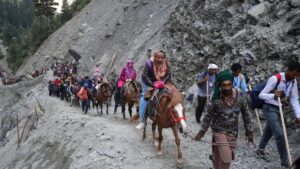Table of Contents
DRDO’s SMART System
Context
Defence Research and Development Organisation (DRDO) successfully flight tested the Supersonic Missile-Assisted Release of Torpedo (SMART) system from Dr APJ Abdul Kalam Island off the coast of Odisha.
About Supersonic Missile-Assisted Release of Torpedo (SMART)
- Type: Next-generation, canister-based, long-range supersonic anti-submarine missile
- Developed by: DRDO for the Indian Navy
- Objective: Enhance the Navy’s anti-submarine warfare capabilities beyond conventional torpedo range
- Features:
- Two-stage solid propulsion system
- Electromechanical actuator system
- Precision inertial navigation system
- Can be launched from surface ships or truck-based coastal batteries
- Uses solid fuel and a silver zinc battery
- Performance:
- Range: The missile has a range of 643 km carrying a light weight torpedo of range 20 km with 50 kg high explosive warhead.
- Functionality: Extends the operational range of conventional torpedoes
- Guidance: Inertial navigation system (INS) with datalink for real-time course correction and target updates
- Additional Details:
- Employed sea skimming technique to evade radar and infrared detection
- Uses acoustic homing for target location.
GST Collection
Context
- Goods and services tax (GST) collection touched a record ₹2.10 trillion in April 2024.
- This represents a 12.4% year-on-year increase, driven by a surge in domestic transactions (up 13.4%) and imports (up 8.3%).
- After accounting for refunds, the net GST revenue came in at Rs 1.92 lakh crore, reflecting a 15.5% rise compared to April 2023.
Factors Contributing to the Rise
- Strong economic momentum and efficient tax collection efforts by authorities are credited for the record-breaking numbers.
- Increased domestic transactions and higher compliance due to anti-evasion measures and audits are highlighted factors.
Performance of Different States
- State-wise data shows 19 states/UTs exceeding the national growth average of 12.4%. Maharashtra topped the list with a collection of Rs 37,671 crore (13% growth).
Performance Across States
- Several states witnessed significant growth:
- Karnataka (Rs 15,978 crore, 9% growth)
- Gujarat (Rs 13,301 crore, 13% growth)
- Uttar Pradesh (Rs 12,290 crore, 19% growth)
- Tamil Nadu (Rs 12,210 crore, 6% growth)
- Haryana (Rs 12,168 crore, 21% growth)
- However, some North-eastern states and Jammu & Kashmir, Lakshadweep, Andaman and Nicobar Islands registered a decline in GST collections.
Expert Opinions
- Tax experts attribute the growth to economic activity, stricter audits, and improved business compliance due to GST audits and notices.
- They expect GST collections to stay around Rs 1.7-2 lakh crore in the coming months, with a potential rise during the festive season.
- Concerns remain regarding the impact of the ongoing heatwave and monsoon on manufacturing, services output, and overall economic activity.
Breakup of GST Collections
- The total collection comprised:
- Central GST (CGST): Rs 43,846 crore (tax levied on intra-state supplies by the Centre)
- State GST (SGST): Rs 53,538 crore (tax levied on intra-state supplies by states)
- Integrated GST (IGST): Rs 99,623 crore (including Rs 37,826 crore collected on import of goods)
- Cess: Rs 13,260 crore (including Rs 1,008 crore collected on import of goods)
Settlement of IGST
- The central government settled Rs 50,307 crore to CGST and Rs 41,600 crore to SGST from IGST collections.
- This resulted in a total post-settlement revenue of Rs 94,153 crore for CGST and Rs 95,138 crore for SGST in April.
Future Outlook
- Seasonal Variations: Collections might fluctuate with changes in the weather and its impact on economic sectors like agriculture.
- Regulatory and Economic Factors: Evolving consumption patterns, regulatory changes, and global economic shifts are expected to influence future GST collections.
|
Quick Facts |
| History of GST in India: A Timeline
● 2000: The Kelkar Task Force proposed a nationwide GST to simplify the tax structure. ● 2009: The Empowered Committee of State Finance Ministers releases the first discussion paper on GST design and implementation. ● 2011: The Constitution Amendment Bill for GST is introduced but faces challenges. ● 2014: The revised Constitution (122nd Amendment) Bill is introduced in Parliament. ● May 2015: The Lok Sabha passes the GST Amendment Bill. ● August 2016: The Rajya Sabha and Lok Sabha pass the amended GST Bill. ● September 8, 2016: The President grants assent to the 101st Amendment Act, enacting GST. ● September 12, 2016: The GST Council is formed. ● July 1, 2017: GST is implemented, replacing existing Central and State taxes. |
Water Ice On Moon
Context
- Indian space scientists have conducted a study that indicates a higher likelihood of water ice in the moon’s polar craters.
- The research was a collaborative effort involving ISRO’s Space Applications Centre (SAC), IIT Kanpur, the University of Southern California, Jet Propulsion Laboratory, and IIT (ISM) Dhanbad.
Key Findings of the Research

- The study suggested that the amount of subsurface ice in the first couple of metres is about five to eight times larger than the one on the surface in both poles
- Also the study suggested that the extent of water ice in the northern polar region is twice that in the southern polar region.
- The study emphasises the importance of this ice for future lunar missions and long-term human presence on the moon.
- Drilling on the moon to extract these ice samples will be crucial for the success of future missions.
- The study also connects the presence and distribution of water ice with lunar volcanic activity and impact cratering.
- These findings are essential for accurately understanding water ice distribution and depth, which is vital for planning future lunar exploration missions aimed at studying lunar volcanism and other geological processes.
Examples, Case Studies and Data for Value Addition
- Use of technology in Administration, Dedication to Public Service (GS 4):
- In Erode District in Tamil Nadu, District Collector Raja Gopal Sunkara introduced IoT devices in 50 habitations across 16 villages to address the inefficiencies of the traditional Over Head Tanks (OHTs) system used for water distribution.
- These IoT devices automate the water pumping process, provide real-time tank level alerts, prevent overflow, and enable scheduled water supply.
- This system has reduced electricity bills by 40% and increased water supply by over 20%, thereby enhancing the reliability and efficiency of water distribution in the district.
- The initiative, funded by various sources including the village panchayat general fund and Central Finance Commission funds, also alleviates the burden on women who previously spent considerable time managing water availability.
- The successful pilot projects have prompted plans to expand this technology to other villages, improving water accessibility and management throughout the district.


 Operation Shiva 2025: Indian Army’s Ma...
Operation Shiva 2025: Indian Army’s Ma...
 World Youth Skills Day 2025, Theme, Hist...
World Youth Skills Day 2025, Theme, Hist...
 President Murmu Nominates Four Members t...
President Murmu Nominates Four Members t...





















